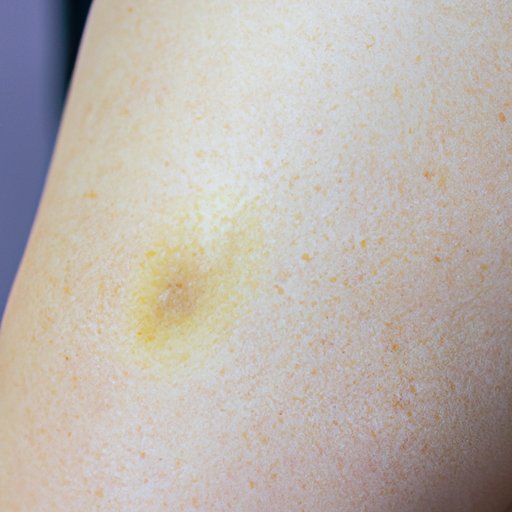I. Introduction
Have you ever been left wondering why your bruise turned yellow? Bruises are a common concern for many people, and their appearance and healing can tell us a lot about our overall health. In this article, we will explore the science behind yellow bruises, the potential health concerns they may signify, and tips for treating and preventing them.
II. The Science Behind Yellow Bruises: A Closer Look at the Healing Process
When we injure ourselves, blood vessels beneath the skin’s surface break, causing blood to leak into the surrounding tissues. The body then begins to repair the damage by sending immune cells and chemicals to the site of the injury. As a result, the affected area may turn various colors as the blood breaks down and the healing process progresses.
A bruise typically goes through several color changes, from red or purple to blue or black, and then eventually yellow or green. These colors are a result of different substances and chemicals involved in the healing process.
Yellow bruises often occur towards the end of the healing process, as the body begins to break down and absorb the damaged tissue. During this time, bilirubin, a waste product produced when the body breaks down red blood cells, builds up and causes the bruise to appear yellow.
The duration of a yellow bruise can vary depending on the person and severity of the injury, but typically last between 1-2 weeks. Factors such as age, the location of the bruise, and underlying health conditions can impact the healing process and cause a bruise to turn yellow sooner or later.
III. What Your Bruises Can Tell You About Your Health: Understanding Yellow Bruises
Our skin’s appearance can be a reflection of our overall health, and yellow bruises may signify underlying issues that should not be ignored. In some cases, recurring yellow bruises may be a symptom of an underlying liver or blood disorder.
Vitamin deficiencies, particularly deficiencies in vitamin C and K, can also impact the healing process and lead to more frequent and prolonged yellow bruising. If you suspect that your bruises are caused by an underlying health condition, it is important to consult with a healthcare professional for proper diagnosis and treatment.
IV. Bruise Management: Tips for Treating and Preventing Yellow Bruises
While some bruises are inevitable and part of the body’s natural healing process, there are steps you can take to treat and prevent yellow bruises from occurring.
General tips for treating bruises include elevating the affected area, applying a cold compress, and taking over-the-counter pain medication. For yellow bruises specifically, applying heat to the area can help promote blood flow and aid in the breakdown of bilirubin.
Preventing bruises altogether can be achieved by wearing appropriate clothing and protective gear, especially when participating in physical activities or sports. Wearing well-fitting shoes and maintaining a healthy diet rich in vitamins and minerals can also aid in bruise prevention.
V. From Hematomas to Heparin: The Medications That Cause Yellow Bruises
Some medications can cause yellow bruises as a side effect. Blood-thinning medications, such as aspirin and heparin, can make it easier for blood vessels to break and lead to more frequent and prolonged bruising. Corticosteroids and chemotherapy agents can also increase the risk of bruising and discoloration.
If you are taking medications that may be causing yellow bruising, consult with your healthcare professional for alternative treatment options or ways to manage the side effects.
VI. Yellow Bruises and Aging Skin: What You Need to Know
As we age, our skin becomes thinner and more prone to bruising and discoloration. This is due to the natural aging process, which causes the protective fat layer beneath our skin to shrink and weaken, making it easier for blood vessels to break.
Older adults can better protect their skin by avoiding excessive sun exposure, moisturizing regularly, and taking steps to prevent falls. Additionally, a diet rich in vitamin C and K can aid in healthier and more efficient wound healing.
VII. Conclusion
The appearance and healing of bruises can be a useful tool in understanding our overall health. Yellow bruises, in particular, can signify underlying health issues, including liver and blood disorders or vitamin deficiencies. By taking the appropriate measures to manage and prevent bruises, we can ensure that our skin stays healthy and can provide us with valuable insight into our overall well-being.
If you are experiencing frequent or unexplained yellow bruising, consult with your healthcare professional for proper diagnosis and treatment measures.
